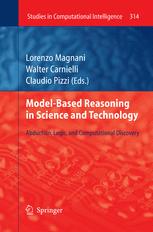Model-Based Reasoning in Science and Technology
Volume 314 of the series Studies in Computational Intelligence pp 221-237
A Visual Model of Peirce’s 66 Classes of Signs Unravels His Late Proposal of Enlarging Semiotic Theory
- Priscila BorgesAffiliated withPontificia Universidade Católica de São Paulo, PUC-SP and FAPESP
Abstract
In this paper I will present the visual model of Peirce’s 66 classes of signs, which I call the Signtree Model, and show how the model helps on developing the enlarged semiotic system that Peirce left unfinished. Peirce’s best-known classification is that of 10 classes of signs. However, in his later years, when developing the sign process in much greater detail, Peirce proposed a classification of no less than 66 classes of signs. In contrast to the first classification, Peirce never worked out the details, making it a difficult topic that has received little attention from semioticians. For a better understanding of the 66 classes, I built the Signtree Model, which makes clear that the 66 classes work together composing a single dynamic system. As the Signtree describes all the 66 classes and visually shows how they are related in a dynamic system, the model can be a powerful tool for semiotic analysis, revealing details of a complex process composed of many elements and multiple relations emphasizing semiosis and the growing of signs. More than that, the Signtree gives clues about philosophical issues such as the relation between semiotic and pragmatism, between semiotic and metaphysics, and the relation among the three branches of semiotic: speculative grammar, critical logical and methodeutic.
- Title
- A Visual Model of Peirce’s 66 Classes of Signs Unravels His Late Proposal of Enlarging Semiotic Theory
- Book Title
- Model-Based Reasoning in Science and Technology
- Book Subtitle
- Abduction, Logic, and Computational Discovery
- Book Part
- I
- Pages
- pp 221-237
- Copyright
- 2010
- DOI
- 10.1007/978-3-642-15223-8_12
- Print ISBN
- 978-3-642-15222-1
- Online ISBN
- 978-3-642-15223-8
- Series Title
- Studies in Computational Intelligence
- Series Volume
- 314
- Series ISSN
- 1860-949X
- Publisher
- Springer Berlin Heidelberg
- Copyright Holder
- Springer-Verlag Berlin Heidelberg
- Additional Links
- Topics
- Industry Sectors
- eBook Packages
- Editors
-
- Lorenzo Magnani (2)
- Walter Carnielli (3)
- Claudio Pizzi (4)
- Editor Affiliations
-
- 2. Università di Pavia
- 3. CLE State University of Campinas
- 4. Università di Siena
- Authors
-
- Priscila Borges (5)
- Author Affiliations
-
- 5. Pontificia Universidade Católica de São Paulo, PUC-SP and FAPESP, São Paulo, Brazil
Continue reading...
To view the rest of this content please follow the download PDF link above.



